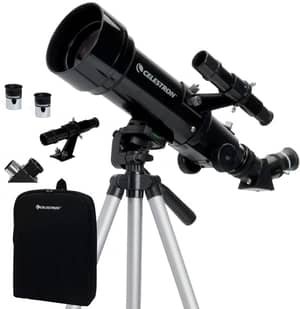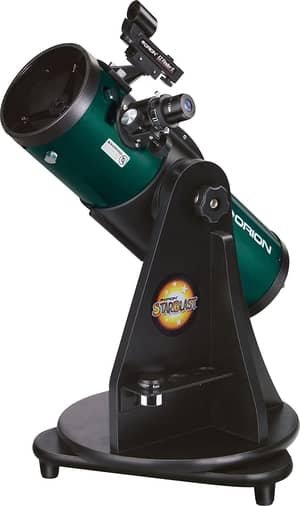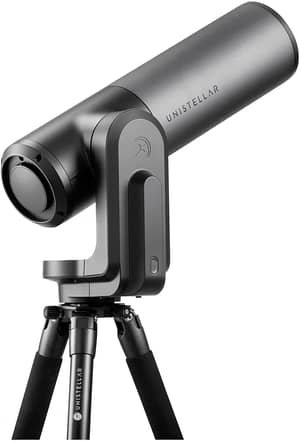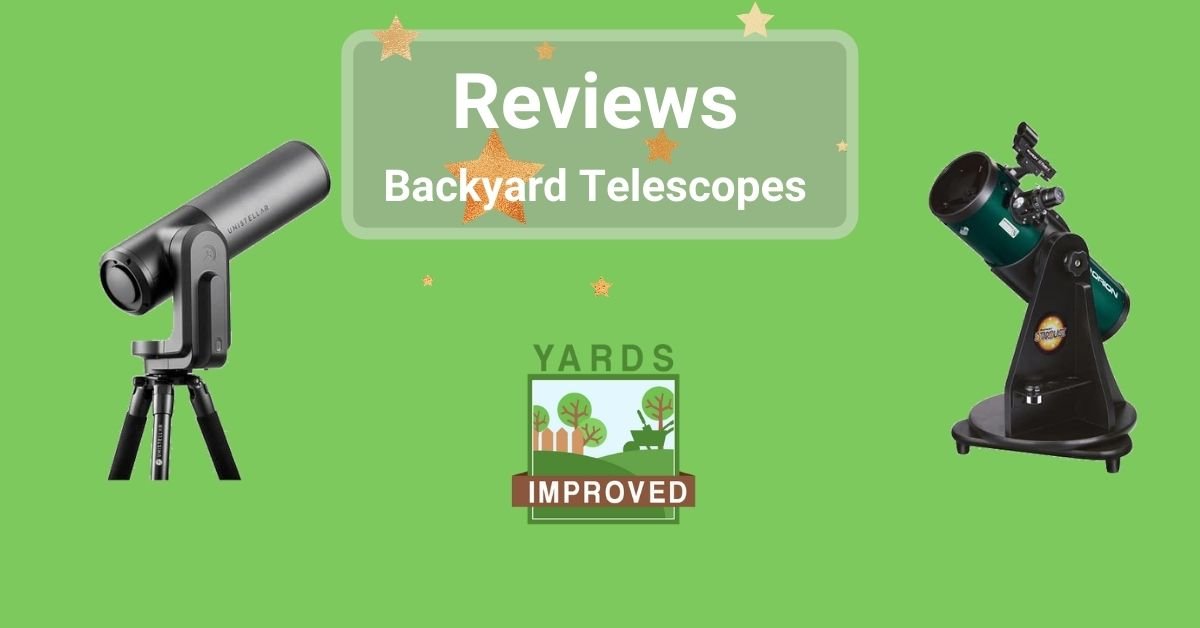You don’t have to go far to enjoy the beauty of the night sky. You can enjoy it right from your backyard! The experience of stargazing will be affected by many things, but even the most light-polluted areas will be able to explore some heavenly bodies. And a telescope is the perfect tool to get started!
There are telescopes of all sizes, interest levels, and skills. They often work in different ways, as well.
How To Enjoy A Backyard Telescope
The solar system, the galaxy, and the entire universe are there to behold! All you need to do is look up. And a telescope – even a basic one – will help you enjoy a fantastic view of what lies beyond planet Earth.
You can learn to identify landmarks on the moon, constellations, and a few stars and planets even without a telescope. With one, you can get a much clearer view. Even in areas with light pollution, there is enough material to study up above that it will keep you busy and excited for years.
A simple star atlas – either in the form of a book or online – can point you in the right direction. Start learning before investing in a telescope so you know what to look for in the night sky. From there, it’s just a matter of learning to adjust the focus and the elevation to find the heavenly body you’re looking for!
We’re going to review a wide range of telescopes. They range from about $100 up to several thousand. They are models of different qualities, but that is because of how each works and how much light it gathers.
Types of Telescope
You know that you look in a lens at one end of a telescope and see the light that comes through a larger lens at the far end. But you might not realize that the way light passes from one lens to the other varies based on the type of telescope.
A refracting telescope is the type that probably first pops into your mind. It has a large concave lens at one end. That lens gathers the light and concentrates it to one point. The size of this lens divided by the length of the tube determines the amount of magnification.
Reflecting telescopes also do exactly what their name says. They reflect light by using internal mirrors. This lets them magnify what you’re looking at.
Of course, you want to gather as much light as possible. So the wider the tube, the better. But mirrors are cheaper and easier to make than the concave glass lenses of refractor tubes. And you can use a shorter tube but add more mirrors, too. That means reflecting telescopes are more economical – both in terms of price and of space.
Both have advantages and disadvantages. Reflectors are less costly, but have more internal pieces, meaning it can be harder to care for them in the long run. You also get more magnification from a reflector than a similar-sized refractor.
On the other hand, refractors are better if you decide to get into astrophotography. They’re also easier to take on camping trips or to stargazing sites.
What Does Telescope Aperture Mean?
Aperture is a term common to cameras and telescopes, and it’s a key factor. It refers to the amount of light captured by the device. For reflecting telescopes, this is based on the size of the primary mirror. For refractors, it’s the size of the large, concave lens.
A higher aperture means you can see dimmer objects. That translates to seeing stars and galaxies that are farther away. For the average person, a refractor with a large aperture won’t be affordable. The majority of the cost is in the lens! But you can get a reflector with a large aperture more affordably.
Telescope Stands, And Why They Matter
Another factor in an enjoyable experience of stargazing is the stand. The more stable, the better!
The most basic stands are simple tripods to hold the scope in place. But better ones include controls that make it easier to adjust where your telescope points. Remember, a small change makes a big difference when we’re looking at objects hundreds of millions of miles away!
The best telescopes have stands that have motors. They allow you to have precision control of where the scope points. Some are controlled from a smartphone app so you can point to the precise spot of a distant target.
The Best Backyard Telescopes, Reviewed
With this basic understanding of how telescopes work and what to look for, let’s dive in and look at some great beginner options! In this case, we’ve listed them from the least to the most expensive.
Celestron 20135 Portable Travel Telescope


- Type: Refracting Telescope
- Aperture: 70 mm
- Mount type: Altazimuth
- Focal length: 400 mm
- Magnification: 20x, 40x
Celestron is a leading name in telescopes. And this basic, entry-level model doesn’t disappoint. If you just want to test the waters a bit, this is an ideal piece. It’s also great if you want a scope that’s easy to take on trips.
At 70 mm, the aperture is a nice size for the price. It also includes a tripod stand and a back for transporting it.
This is a simple scope for beginners. It offers a good introduction to the hobby, but it won’t take long to get hooked and want a better one. If you’re not too sure that you’ll be into astronomy, it’s a good starting point. But if you are ready to commit, consider a better tool.
You also get unlimited technical support and a two-year warranty.
Zhumell Z114 Portable Altazimuth Reflector Telescope


- Type: Reflecting Telescope
- Aperture: 114 mm (4.5 inches)
- Mount type: Altazimuth – Dobsonian
- Focal length: 456 mm
- Magnification: 27x, 46x
This reflector telescope offers an inspiring view of the sky. It even has a red dot finder to make it easier to aim!
It includes both 17 mm and 10 mm eyepieces to offer a variety of magnifications. A larger eyepiece helps you “zoom out” a bit. You can buy different sizes. For instance, at the included sizes, the moon may appear too close. You might not be able to catch the entirety of some star clusters in one view. But adding a different eyepiece will improve this. It uses a standard 1.25-inch eyepiece.
One difference, though, is that this sits on a table instead of a stand. If you have a backyard table or picnic bench, it’s ideal! You could remove the base and mount it on another tripod, however.
Celestron PowerSeeker 127EQ Telescope


- Type: Reflecting Telescope
- Aperture: 127 mm (5 inches)
- Mount type: Altazimuth
- Focal length: 1000 mm
- Magnification: 50x, 250x
This is another high-quality entry-level scope, especially if you want to look at distant stars! For the nearby planets and the moon, you’ll be able to see a lot of detail. And you’ll have a great view of the rings of Jupiter and its moons! Of course, it takes time and practice to learn to find and focus these, but the telescope has the power to do it.
It includes a simple tripod and the opportunity to download Celestron’s stargazing software package. The tripod also has an accessory tray to keep your equipment handy.
It includes three eyepieces: 4 mm, 20 mm, and a Barlow eyepiece, which is used in conjunction with another eyepiece to triple the magnification.
Orion 10015 StarBlast 4.5 Astro Reflector Telescope


- Type: Reflecting Telescope
- Aperture: 114 mm (4.5 inches)
- Mount type: Altazimuth – Dobsonian
- Focal length: 456 mm
- Magnification: 27x, 46x
You’ll be enjoying the star clusters in Orion’s Belt and elsewhere with this great reflector telescope from the namesake brand. With a great aperture, focal length, and quality accessories, it will help you enjoy the mysteries of the universe.
This scope comes with a tabletop mount. It’s fully assembled out of the box, so you won’t waste any time getting it set up!
With low light pollution (suburban standards), you’ll be able to see far-off star clusters. This scope is more suited to these deep-space objects than the planets or moon, but you could change the eyepieces if you want to focus on nearby bodies. The two included options are 17 mm and 6 mm standard 1.25-inch versions.
Unistellar Evscope eQuinox


- Type: Refracting Telescope
- Aperture: 114 mm (4.5 inches)
- Mount type: Altazimuth – motorized
- Focal length: 450 mm
- Magnification: 50x optical; 150x digital (recommended); 400x digital (maximum)
- Requires 1 lithium ion battery
Ready to make a more substantial investment? You’ll be making a considerable leap in price if you choose the eQuinox.But if you’re serious about astronomy, you’ll be ecstatic with this purchase.
This telescope is best for deep sky objects. You won’t be able to view the entire surface of the moon, but you can see distant clusters.
Besides the quality of the optics, you also have the advantage of a motorized mount with this scope. That makes it easier to find objects. The telescope also tracks them – that is, it moves slowly as the Earth changes in position relative to what you’re viewing. So you can always keep the stars in focus!
It’s costly, but it offers many advanced features that anyone serious about the hobby will love. It even has the option to upload observation information for analysis in case you notice something that doesn’t seem “quite right.”
Conclusion
There’s so much to see out in space that you can observe right from your backyard! You can get started in the wonderful hobby of astronomy with an inexpensive telescope, or take the leap and get a better one right from the beginning. We feel confident that you’ll enjoy any of the ones we’ve reviewed here!









